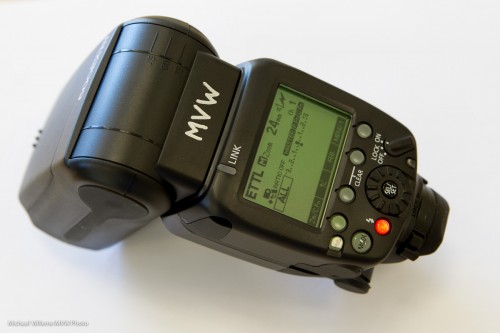So, in the past weeks I have:
- Lost a 580EX II flash
- Broken my car windshield (gravel truck, pebble…)
- Broken my second 580EX II flash.
I have therefore had to go out and buy a 600 EX-RT. A not actually more powerful flash (600 refers to the highest guide number, but Canon has just upgraded the Guide Number table to include higher zoom settings – the actual head is the same power as the 580’s, it just has a 200mm zoom setting – and more zoom means more concentrated power forward), but one that has been significantly upgraded.
Here it is:
First – very first – impressions:
- It’s just like a Nikon SB900!
- But it now adds radio control (2.4 GHz, like WiFi) as a built-in option for controlling remote flashes. A Pocketwizard Flex killer? I never tried out the TTL Pocketwizards (the company was rather slow and difficult in getting test models to me, so I use the “dumb” industry-standard Pocketwizard II Plus, of which I have six), but if I were Pocketwizard I would probably be worried. Radio is evidently superior to light, especially outdoors.
- The radio control is, however, useless until you have other Canon radio-operated wireless devices, and there are few so far. I.e. until a new 430 replacement comes out, buy even more 600EX flashes. And with six existing 430s I am not about to start using radio to obsolete all those – you cannot mix radio-control and light-control: it is one or the other.
- My 1D Mk IV controls the 600EX-RT – but not all of it. The custom menus are only partly controllable with my 7D and 1D Mark IV cameras. (Upgrade, Canon?)
- Still no optical slave? This function (which Nikon calls “SU-4 mode”), would be very welcome. If it exists I have not yet found it.
- The new Custom Functions Menu is fairly intuitive. As is operation in minutes. Which is a nice change. But still, I can poke holes in the User Interface in minutes, and, not being a committee of older gentlemen ruled by consensus, I could improve it in minutes…
- Wireless flash has its own button now.
- But it takes a week, well, something like ten seconds, of holding down the C.Fn button to get to the Custom Functions.
- A possible warning sign for me: there’s a temperature overload feature and warning. I do hope this does not mean this flash has turned into a Nikon overheating flash: one outstanding feature of the Canon flashes has been that you can fire them at whatever power you need all night – and as an event and creative shooter, I very often do.
- The new optional “beep” seems erratic. It is meant to sound when the flash is charged, but it often does not do this – eg when it has fired at low power. At best, the feature is very poorly documented.
- Communication between the 600EX and my 1D Mk4 is erratic when I attempt to change FEC (flash compensation) on the flash as well as on the camera (which is bad practice but easily done).
- I like the new “light distribution” feature (alas, in a custom menu, whereas Nikon has a switch) that enables you to spread the light a little closer, or to concentrate the beam a little more for vignetting and more effective power).
- Compatibility with older cameras is doubtful. Canon says you lose synch speed unless you use a 5D MK3/1Dx camera, but it appears all is well on my cameras so far. Mmm.
I think a software upgrade would solve some of the issues; but they can generally be worked around.
This updated flash is an investment in the future that also works for today, but that may (willy-nilly or voluntarily) speed up our move towards that future.
Stay tuned for more impressions, and some images, soon.

